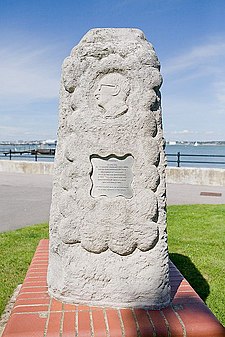Christopher Cockerell
| Christopher Cockerell | |
|---|---|

Memorial to Sir Christopher Cockerell at Hythe
|
|
| Born |
4 June 1910 'Wayside' Cavendish Avenue, Cambridge, United Kingdom |
| Died | 1 June 1999 (aged 88) Hythe, Hampshire, United Kingdom |
| Residence | England, United Kingdom |
| Citizenship | British |
| Nationality | British |
| Fields | Mechanical Engineering |
| Alma mater | Peterhouse, Cambridge |
| Known for | Hovercraft |
| Notable awards |
Fellow of the Royal Society RDI Elmer A. Sperry Award Royal Medal (1966) Albert Medal (1966) |
Sir Christopher Sydney Cockerell CBE RDI FRS (4 June 1910 – 1 June 1999) was an English engineer, best known as the inventor of the hovercraft.
Cockerell was born in Cambridge, where his father, Sir Sydney Cockerell, was curator of the Fitzwilliam Museum, having previously been the secretary of William Morris. Christopher attended the primary school of St Faith's. Christopher was educated at Gresham's School, Holt, Norfolk. He matriculated to Peterhouse, Cambridge to read mechanical engineering and was tutored by William Dobson Womersley. He was later to return to Cambridge to study radio and electronics.
He began his career working for the W. H. Allen & Sons of Bedford. After returning to Cambridge University in 1934 to study radio and electronics, he went to work at the Radio Research Company. In 1935 he went to work at the Marconi Company, and soon afterwards he married Margaret Elinor Belsham (4 September 1913 – September 1996). They lived at the now Grade II listed Gay Bowers Cottage in Danbury, Essex from 1940 to 1951. During his time in Chelmsford, he led a research team in the famous Marconi hut at Writtle and worked on many systems, including radar. After the war he contributed to the development of several very sophisticated pieces of equipment, including radio location technology, and the first equipment used by the BBC in Alexandra Palace.
After he left the Marconi Company, he bought Ripplecraft Ltd., a small Norfolk boat and caravan hire company, with a legacy left by his father in law. The firm made little money, and Cockerell began to think how the craft could be made to go faster. He was led to earlier work by John I Thornycroft and Sons, in which a small vessel had been partially raised out of the water by a small engine.
...
Wikipedia
